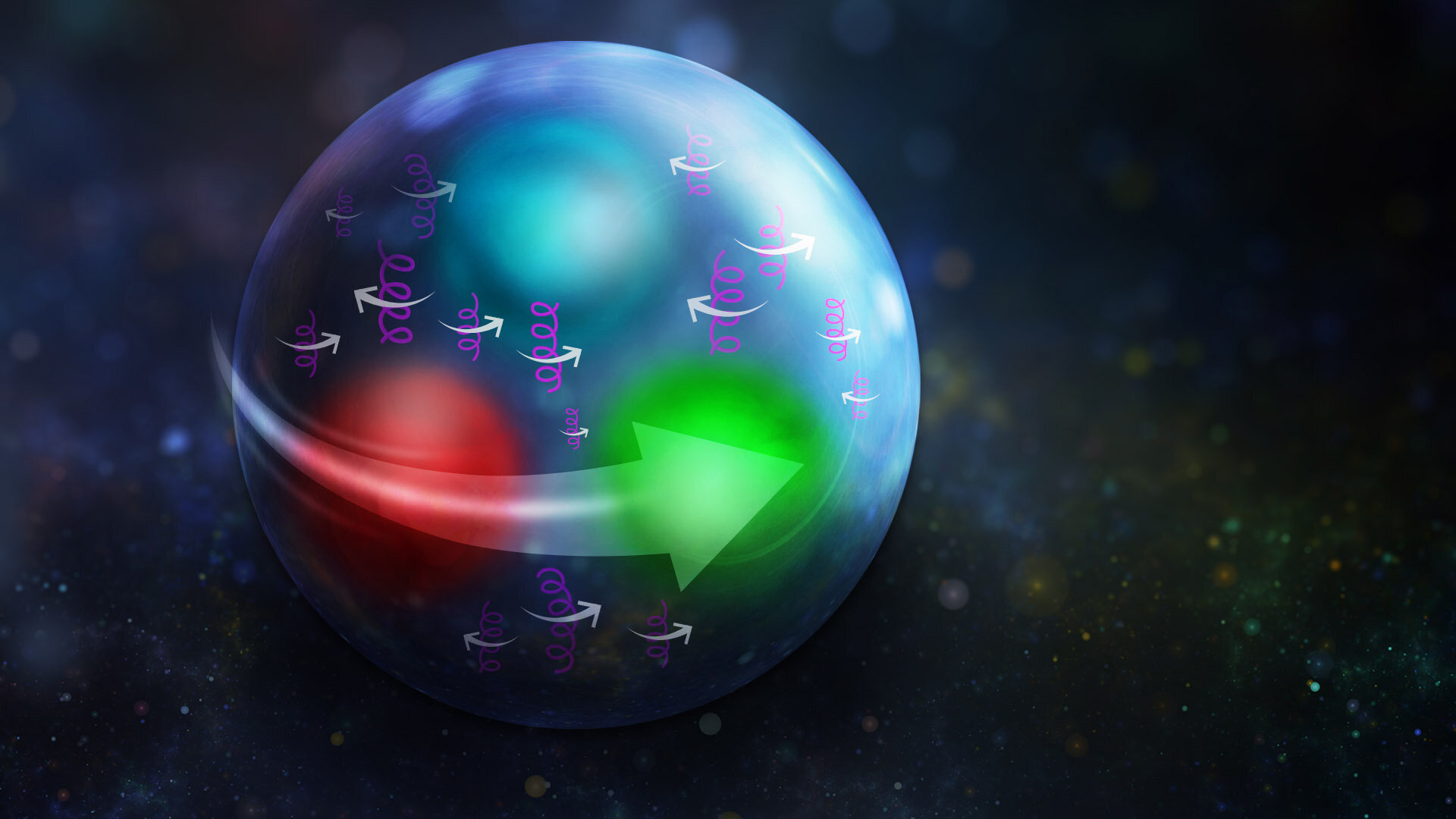A global analysis of experimental data and Quantum Chromodynamics calculations of the lattice provides insight into the role of the gluons (purple coils) that contribute to the spin of the nucleon. Gluons are manifestations of the. Credit: Jefferson Lab
Nuclear physicists have long been working to reveal how the proton gets its spin. Now, a new method that combines experimental data with advanced calculations has provided a more detailed picture of the spin contributions of the glue that holds protons together. It also paves the way for imaging the 3D structure of the proton.
The work was led by Joseph Karpie, a postdoctoral associate at the Center for Theoretical and Computational Physics (Theory Center) at the U.S. Department of Energy’s Thomas Jefferson National Accelerator Facility.
He said this decades-old mystery began with measurements of the sources of the proton’s spin in 1987. Physicists originally thought that the proton’s building blocks, quarks, would be the main source of the proton’s spin. But that’s not what they found. It turned out that the quarks of the proton provide only about 30% of the total measured spin of the proton. The rest comes from two other sources that have so far proven more difficult to measure.
One of them is the mysterious but powerful strong force. The strong force is one of the four fundamental forces in the universe. It is what “glues” quarks together to form other subatomic particles, such as protons or neutrons. Manifestations of this strong force are called gluons, which are thought to contribute to the spin of the proton. It is believed that the last bit of spin is due to the motions of the proton’s quarks and gluons.
“This paper is kind of a coming together of two groups at the Theory Center who have been working on trying to understand the same bit of physics: how do the gluons inside contribute to the rate at which the proton spins,” he said.
He said this study was inspired by a puzzling result that emerged from initial experimental measurements of the gluons’ spin. The measurements were performed at the Relativistic Heavy Ion Collider, a DOE Office of Science user facility at Brookhaven National Laboratory in New York. The data initially seemed to indicate that the gluons might contribute to the proton’s spin. They showed a positive result.
But as data analysis improved, another possibility emerged.
“When they improved their analysis, they got two sets of results that seemed very different: one was positive and the other was negative,” Karpie explained.
Although the previous positive result indicated that the spins of the gluons are aligned with those of the proton, the improved analysis left open the possibility that the spins of the gluons make an overall negative contribution. In that case, a larger part of the proton spin would come from the motion of the quarks and gluons, or from the spin of the quarks themselves.
This puzzling result was published by the Jefferson Lab Angular Momentum (JAM) collaboration.
Meanwhile, the HadStruc collaboration had tackled the same measurements in a different way. They used supercomputers to calculate the underlying theory that describes the interactions between quarks and gluons in the proton: Quantum Chromodynamics (QCD).
To equip supercomputers to perform these intensive calculations, theorists simplify some aspects of the theory somewhat. This somewhat simplified version for computers is called lattice QCD.
Karpie led the work to bring together the data from both groups. He started with the combined data from experiments at facilities around the world. He then added the results of the lattice QCD calculation to his analysis.
“This brings together everything we know about quark and gluon spin and how gluons contribute to the spin of the proton in one dimension,” said David Richards, a senior staff scientist at Jefferson Lab who worked on the study.
“When we did that, we saw that the negative things didn’t disappear, but they changed dramatically. That meant there was something funny going on with it,” Karpie said.
Karpie is lead author of the study recently published in Physical examination D. He said the main conclusion is that combining the data from both approaches produced a more informed result.
“We combine both of our datasets together and get a better result than we could achieve separately. It really shows that we learn a lot more by combining lattice QCD and experimenting together in one problem analysis,” said Karpie. “This is the first step, and we hope to continue to do this with more and more observable data and we will create more grid data.”
The next step is to further improve the datasets. As more powerful experiments yield more detailed information about the proton, these data begin to paint a picture beyond one dimension. And as theorists learn how to improve their calculations on increasingly powerful supercomputers, their solutions also become more accurate and comprehensive.
The goal is to ultimately obtain a three-dimensional understanding of the proton’s structure.
“So we’re learning that our tools work in the simpler one-dimensional scenario. By testing our methods now, we’ll hopefully know what to do if we want to move up the ranks with 3D structures,” Richards said. “This work will contribute to this 3D picture of what a proton should look like. So it’s all about finding our way to the heart of the problem by doing these simpler things now.”
More information:
J. Karpie et al, Gluon helicity from global analysis of experimental data and lattice QCD Ioffe time distributions, Physical examination D (2024). DOI: 10.1103/PhysRevD.109.036031
Provided by Thomas Jefferson National Accelerator Facility
Quote: Combining theory and experiment to shed new light on proton spin (2024, May 24) retrieved May 24, 2024 from https://phys.org/news/2024-05-theory-combine-proton.html
This document is copyrighted. Except for fair dealing purposes for the purpose of private study or research, no part may be reproduced without written permission. The content is provided for informational purposes only.
